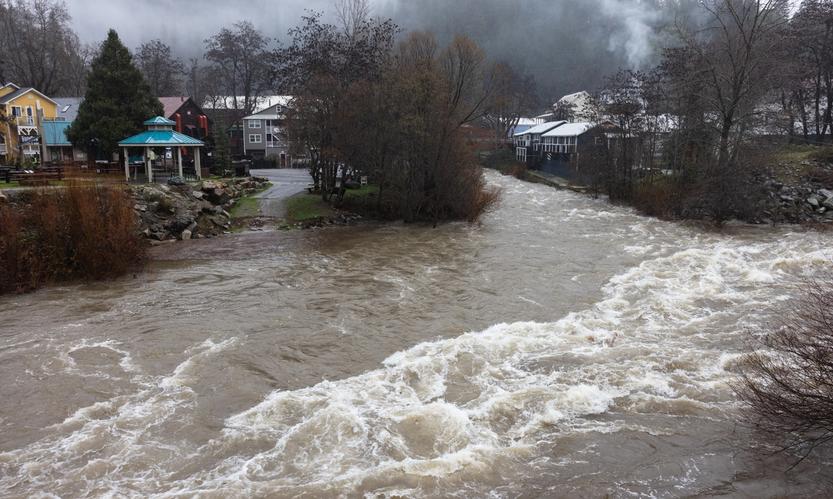Southwest Sierra #68 — Meet the Neighbor
July 24, 2024

SPI Milling Operation in Quincy, CA. Currently there are 9 job openings in Quincy. Photo courtesy of spi-ind.com.
Southwest Sierra #65 ended with a promise to discover the connection between “Southern Pacific Industries” (SPI) and the Southern Pacific Railroad. Imagine my surprise when I spoke to Mark Luster SPI’s Community Relations Manager and learned that, for my entire life, I’ve had SPI’s name wrong! SPI stands for Sierra Pacific Industries, not Southern Pacific Industries. It is strange how sometimes, when we have something in our minds a certain way, we only see it that way. I looked at their website multiple times and did not notice the correct name! I suspect that others who know the correct name did not notice my error for the same reason. Locals refer to the company simply as “SPI”.
As previously explained, SPI owns most of the private 1-mile square sections of land in our immediate vicinity. The checkerboard pattern is broken in places where preemptive rights such as mining claims existed prior to the passage of the 1862 Pacific Railroad Bill. The square sections were deeded to the Central Pacific Railroad Company in the 1860s. The Central Pacific Railroad later merged with the Southern Pacific Railroad Company. Southern Pacific put their vast landholdings up for sale in the early 1980s. The owners of Sierra Pacific Industries, the Emmerson Family, purchased Southern Pacific’s offerings in California. This is how SPI became our neighbor here in the Tahoe National Forest.
Per SPI Tahoe District Manager Joe King:“SPI’s ownership in Sierra County is about 50,000 acres. Sierra County itself is about 616,000 acres total. According to the map from the LAFCO formation documents, SPI has close to 18,000 acres in the Pliocene Ridge Community Services District.”
According to SPI’s website Sierra Pacific Industries - Home Page (spi-ind.com) they own 2.4 million acres of land and are one of the largest lumber producers in North America. Not only do they grow their own timber, but they are also one of the largest purchasers of logs and timber in North America. SPI employs about 6,000 crew members in over 30 States. Their website is very interactive and covers a wide range of topics related to both the company and forest management.
I learned that the company does a lot more than grow timber for lumber production. They produce several lines of “value added” products with their lumber, such as: doors, windows, fencing and landscape chips. In California they have co-gen plants in the towns of Burney, Quincy, Sonora and Anderson. Co-gen plants use steam twice, once to heat kilns to dry lumber and again to turn a turbine to make electricity. The co-gen plants are powered by the waste from their timber and milling operations and generate 2/3 of the energy needed for their operations.
The site includes sections about carbon sequestration, environmental stewardship, sustainable forestry and wildfire. The company uses state-of-the art technology in their mills and logging operations to minimize environmental impacts and waste. I was impressed with the level of cooperation that the company has with the Forest Service and other governmental agencies. They actively participate in ongoing studies on various forest health issues. They even have staff dedicated to locating rare plants and animals. SPI has contributed over 1,500 occurrences of rare plants to the State database since the program began (typically they report 200 per year).
Per Joe King, in our area “A Timber Harvest Plan (THP) is currently being written by a SPI forester to do timber harvest activities in the Pike/Magnus Orchard area. Silviculture covered by the THP will include Commercial Thin, Clearcut, and Fuel break. The THP is expected to be submitted to Cal Fire this fall for review and approval. Ops may start any time after approval, but the fuel break work is the highest priority.
SPI is currently collaborating with the Yuba River Ranger District of the Tahoe National Forest to coordinate implementation of the fuel break across SPI and federal ownership so that it may form a contiguous shaded fuel break along Ridge Road, down Magnus Orchard Road and down the ridgeline between Indian Creek and Kanaka Creek/Middle Yuba River. We hope to begin initial work on the fuel break this fall after all environmental documents and reviews have been completed and approved.”
By partnering with the Forest Service, SPI and the Forest Service are at least partially overcoming the hurtle that the checkerboard pattern of land ownership represents. As Mark Luster explained to me, in the 1860s when public land was deeded to the railroad companies nobody was thinking about forest management. I asked him if SPI participates in land swaps and the answer was “Yes, lots of land swaps”. I asked him if there has ever been a discussion about doing MAJOR swaps with the railroad deeded land and federally owned public lands. He said that it would be difficult at this point in time to do something like that. I’m sure that he was referring to the fact that so much of the land has already been claimed for other uses. He did not disagree that it would be a “win-win” to defragment the privately and publicly owned forest land if it could be done.
Special thanks to Joe King and Mark Luster for answering my questions.
Featured Articles

Storms Bring Heavy Rainfall and Local Disruptions →
December 22, 2025
Sierra County faces power outages and water issues amid heavy rainfall and storm warnings.
215 Animals Seized for Cruelty from Grass Valley Property →
December 22, 2025
Human Remains Found Near South Yuba Bridge in March Identified →
December 17, 2025
Transfer Station Burn Suspended After Community Concerns →
December 16, 2025
Sierra Hardware Plans Extensive Repairs After Flood Damage →
December 8, 2025